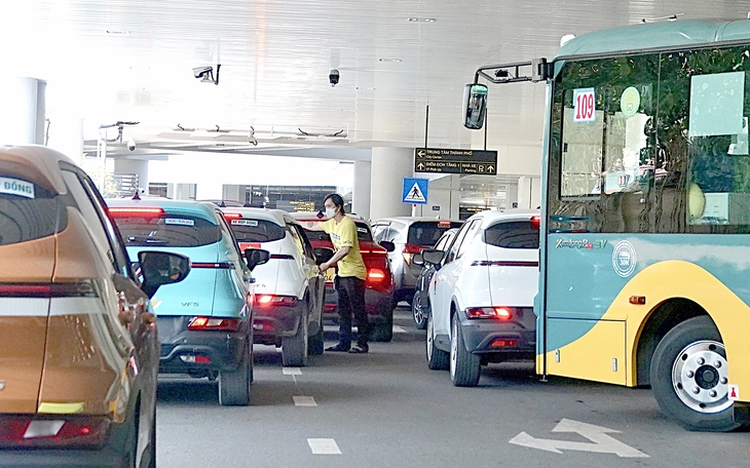
The taxi and ride-hailing vehicle waiting area at Tan Son Nhat International Airport in Ho Chi Minh City becomes overcrowded during peak hours. Photo: T.T.D. / Tuoi Tre
Passengers have reported feeling 'neglected,' especially when trying to find ride-hailing vehicles.
The terminal, built with three above-ground levels and one basement, is organized as follows: Level 3 serves departing passengers, Level 2 is designated for private car arrivals, and Level 1 accommodates buses, taxis, tour buses, and ride-hailing vehicles.
However, Tuoi Tre (Youth) newspaper on Sunday found that concerns arose as arriving passengers disembarking on Level 2 were required to go down to Level 1 to catch a taxi, leading to crowding at elevators and escalators.
This is inconvenient for those with bulky luggage or strollers.
Quynh Nhu, a passenger who flew from Hanoi to Ho Chi Minh City, shared her experience: after retrieving her luggage, she had to queue at a crowded elevator to reach Level 1.
Upon arrival, she was met with chaos as taxis, buses, and ride-hailing cars shared a single lane. During peak times, 15–20 vehicles lined up, while bus traffic made the area even more congested.
Nhu pointed out that a large open area in front of the terminal is reserved for priority vehicles, while the taxi pickup area remains cramped.
She suggested airport authorities reassess and reorganize the traffic flow for passenger convenience.
Taxi drivers have also voiced frustrations.
N.V.K., a driver of a major taxi company, said Level 1 is overcrowded with vehicles ranging from buses to contract cars, taxis, and ride-hailing services.
With limited space, taxis often wait long periods just to reach pickup points. Sometimes, picking up a passenger takes more time than driving from the airport to the city center.
The taxi pickup lane at Level 1 intersects with bus entry and exit routes, creating a bottleneck and frequent traffic jams.
Drivers say Vietnamese passengers can usually navigate the confusion by asking staff or calling their rides, but international travelers struggle more.
“Foreign tourists often wander around looking for taxis, some even dragging luggage toward the bus area or out to the main road. It’s hard for us to help because we’re not allowed to stop outside the designated zones,” one driver said.
First-time app-based drivers are also struggling with the complex layout.
Thanh Hien, a ride-hailing driver, said he had to rely entirely on GPS to navigate the terminal, as the road system in front of T3 is confusing.
Notably, T3 lacks a designated pickup zone for two-wheeled ride-hailing vehicles.
During rush hours, the disorderly taxi pickup area has led to reports of price gouging, especially for short trips.
Huu Thanh, who lives in Phu Nhuan Ward, said he accidentally went to Terminal 3 instead of Terminal 1. He needed a ride between the two terminals — only 2–3 kilometers apart but he was quoted VND100,000-150,000 ($3.8-5.7).
Minh Chi, 34, who had just landed from northern Hai Phong City, spent nearly 20 minutes trying to book a ride with no drivers accepting her request.
“This is supposed to be a modern aviation facility, yet there’s no proper pickup point for motorbikes. Passengers are left waiting in the sun and often approached by unauthorized drivers offering rides at unregulated prices,” she said.
Some passengers found the presence of traditional motorbike taxis and street vendors near the terminal entrance to be unsightly and unpleasant.
Tan Son Nhat International Airport currently provides a free shuttle bus service connecting T1, T2, and T3 Terminals at 10- to 15-minute intervals.
However, passengers have complained that the waiting time is often long and the number of shuttles insufficient, especially for those rushing to catch connecting flights.
Modern infrastructure must also be user-friendly
While T3 is Vietnam’s most modern terminal, with spacious facilities and efficient baggage handling, traffic-related problems, including overcrowded elevators, cramped pickup areas, price gouging, and lack of designated zones for app-based services, are diminishing its value.
Khanh Linh, director of a media and event planning company in Binh Thanh Ward, commented that an international airport should be judged not only by its aesthetics but also by the passenger experience.
She emphasized the need for urgent traffic reorganization at T3: separating lanes for taxis, buses, and ride-hailing vehicles; better coordination of taxi queues; and strict fare listing regulations to eliminate price gouging.
She also suggested opening designated zones for both two-wheeled and four-wheeled ride-hailing vehicles, installing bilingual signage, and adding more elevators and escalators to ease access between Levels 1 and 2.
During off-peak hours, taxis should be allowed to pick up passengers at Level 2 to ease congestion.
A representative of the Airports Corporation of Vietnam told Tuoi Tre that it had acknowledged the public’s concerns and would instruct relevant units to make adjustments as needed.
For now, airport security staff have been deployed to manage traffic flow and prevent congestion in pickup zones.
Meanwhile, the Ho Chi Minh City Department of Construction reported that signage had been installed and traffic flow enhanced.
Vehicles coming from Tran Quoc Hoan, Cong Hoa, and Truong Chinh Streets will use the overpass in front of T3 Terminal to avoid congestion.
T3, the country’s largest domestic terminal, officially opened on April 19. Its construction began in December 2022.
The project comprises a passenger terminal, a multi-story parking facility with commercial services, an elevated road system, and an aircraft parking area.
The terminal is expected to serve more than 20 million passengers annually and handle up to 7,000 passengers per hour during peak times.


Max: 1500 characters
There are no comments yet. Be the first to comment.